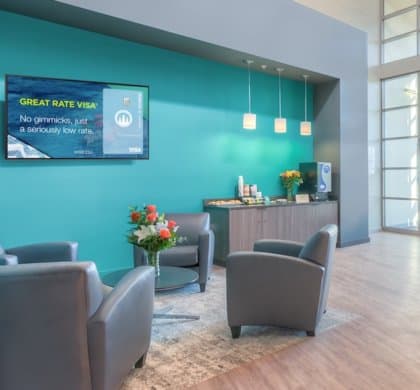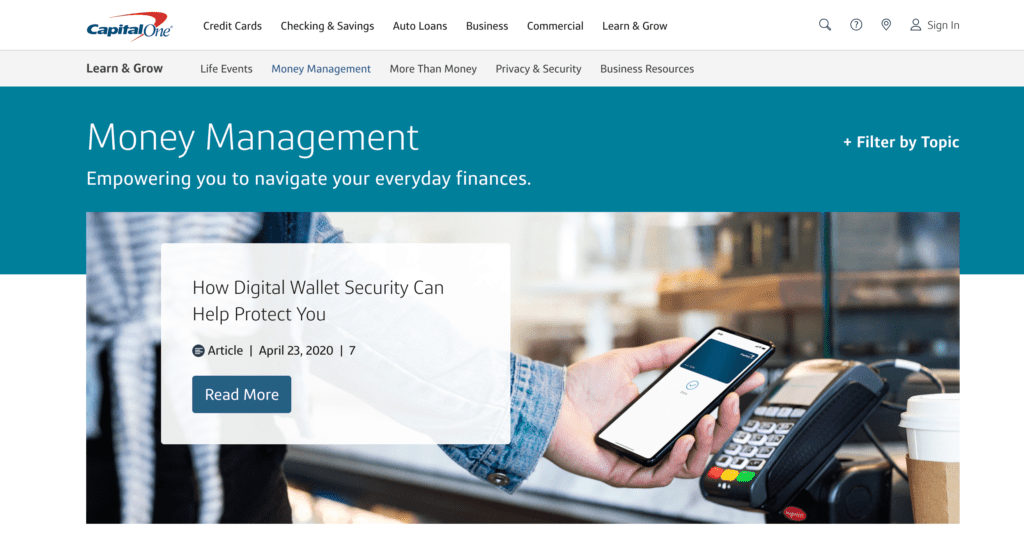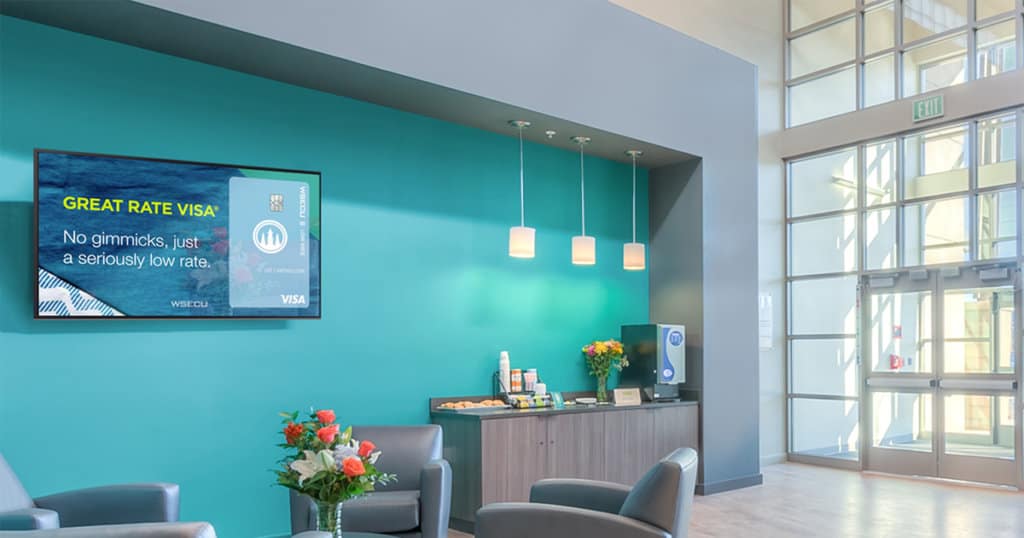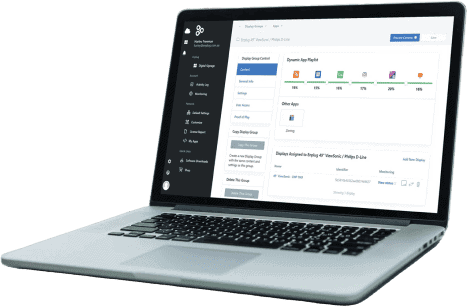
9 Bank Marketing Strategies for 2020
In 2020, consumers have more options than ever to consider when choosing a bank. Online-only options like Simple and extra convenient services like Chase’s no card ATMs are disrupting the market and calling for retail banking executives to get more creative with bank marketing ideas.
We realize pushing through competitor messages can be tough, so we talked with bank marketing and branding experts Josh Mabus of The Mabus Agency, Dan Brill of Brill Creative & HyperDrive, and Peter Jacobs of Shark Communications to get their expert advice.
Here are 9 bank marketing ideas to help you attract and retain customers and establish a unique position in the marketplace in 2020.
1. Blogging
A blogging strategy for your bank can increase traffic to your site, build your social media profiles, and establish expertise.

The Capital One blog offers expert advice that is useful for customers and the public.
Take some of the most asked questions or most voiced concerns from your customers, and turn them into helpful articles on your blog. Use these to feed your social media profiles and provide another platform for customer service.
To produce a well designed, SEO-optimized blog that meets the needs of your customers, remember these important aspects:
- Deliver a great user experience
- Provide a call to action that ties in your services
- Font, color, and content should represent your bank’s brand
- Use images and videos to diversify content
- Establish a consistent and easily readable post format
2. Social Media Content
Social media is a must-use tool to market your bank and establish a brand presence amongst your competitors. However, social media should be used to engage your followers with useful, relevant information — not simply to sell.
87 percent of consumers say that most banks on social media are “annoying, boring, or unhelpful.” You can avoid these stigmas by making sure your strategy doesn’t reflect these common mistakes:
- Only creating content that is self-promoting
- Posting infrequently or irregularly
- Not preparing for negative customer feedback (tips on this here)
- Broadcasting the same message across all channels (Facebook, Twitter, Instagram, etc)
Chase Bank is one of Social Times’ “Top Banks on Social Media.” They develop interesting original content to tell their brand story and connect with their customers. In their “Show Me Your Walk” series they’ve created a series of livestream events to celebrate commencement ceremonies during a time.
Banks should aim to create content that is interesting, engaging, and most of all shareable.
Building a strong bank brand often requires more thought towards strategy, creativity, and innovation to effectively drive consumer engagement and to maximize the advantages of today’s digital media channels and display opportunities.
Peter Jacobs, Shark Communications
3. Customer Service
Exceptional customer service can be built into your marketing strategy and ultimately used to boost your brand image.
To support their customer-first approach, TD Bank created a campaign called #TDThanksYou to solidify themselves as a bank that knows and appreciates their customers. Their team captured customer reactions to unexpected service which resulted in a viral video on their social media profiles.
A great brand image helps to define a bank more distinctly in the marketplace, more importantly, it can create a sense of perceived value in the minds of consumers which often equates to profitability over the long haul
Peter Jacobs, Shark Communications
4. Video Content Campaigns
Your customers expect lively digital content like never before. Take advantage of videos and podcasts to capture their attention. With engaging digital media, you can develop content marketing strategies that position your bank for the best kind of marketing: word of mouth.
With the COVID-19 pandemic, CIBC strategically used video stories to help communicate their brand values and then encourage customers to share those values organically.
They launched “Holidays for Heroes” a campaign that provides travel vouchers to celebrate the sacrifice and commitment of healthcare workers during the COVID-19 crisis.
The call to nominate a friend or family member for a hero’s holiday leads to a dedicated CIBC microsite that raises awareness of the brand’s social contribution. But, the key component of the campaign is a series of videos that highlights each worker and documents the moment they receive the holiday vouchers. The emotional videos give a face to the brand’s values and involves them in promoting the initiative.
The most successful advertising (no matter the medium) facilitates word of mouth in two ways: 1. It makes your audience talk. 2. It tells them what to say.
Josh Mabus, The Mabus Agency
5. Digital Signage
With digital signage, your displays do the selling for you so you don’t have to. Use well-placed displays to show graphics and videos that promote your latest services or tutorials for your latest products. Take fun photos of your best employees and pair them with a call to action like, “Ask Tracy for more information on consolidating your student loans.”

Giving customers something to engage with while they wait to be serviced will improve your branch experience. Show content like the local weather, public transportation routes, traffic updates, live news feeds of top financial blogs, or your own blog feed.
You can leverage digital signage in your branches to support many of the marketing ideas covered in this post. When launching online campaigns (such as Fifth Third’s “Retweet to Reemploy,”) use those same assets for content on your displays. This reinforces your overall brand image to your customers, while also positioning you as a tech-savvy financial institution.
6. Non-Traditional Rewards Programs
When designing a rewards program for your customers, consider these three primary goals:
- Increasing customer loyalty
- Extending retention
- Cross-promoting services and products
Chime offers a unique rewards program that aims to achieve these objectives. For every amount that you spend using your debit card, Chime rounds the total up to the nearest dollar, then automatically deposits the difference into your Chime savings account.
This system achieves customer loyalty by encouraging consistent use of your debit card, which most customers in 2018 do anyway. Retention is influenced because the longer you stay with the bank, the more free money you earn. Lastly, this rewards program provides the perfect opportunity to cross-promote both their checking and savings accounts.
Banks have a broad choice in their marketing plans: Attract and acquire customers with price-based promotions, or develop new customer relationships with a more brand-based strategy.
Peter Jacobs, Shark Communications
7. Strategic Partnerships
Partner up with organizations that share the values of your customer base. This could be through entertainment companies, real estate agencies, or nonprofits.
For example, Citi partners with concert promoter Live Nation to provide pre-sale concert tickets and special offers to popular shows. You simply use your Citi credit card during checkout to redeem the perks.
Connecting with partners and crafting strategic programs like this positions your bank distinctively among competitors.
Banks must realize that they offer parity services and potential customers have an extremely difficult time differentiating between banks.
Josh Mabus, The Mabus Agency
Tip: Use compelling graphics on your digital signage to communicate current partnerships and promotions with branch visitors 24/7.
8. Customer Data
Data will give you clear insight into your existing customer base. With data you can better understand behavior patterns and offer relevant deals that fit within your customer’s daily lives.
Instead of worrying about checking off their social media to-do list, or jumping on board with the latest and greatest technology, banks need to leverage their data to better understand and serve their existing client base.
We see an incredible opportunity for banks to deliver much more personalized, relevant and timely messages to their current customers.
We often get so excited about using technology that we forget about the human beings on the other end. Better to understand and nurture what you have than to always be looking for more.
Dan Brill, Creative Evangelist
Here is an example of how banks can effectively use big data to improve the customer experience, increase retention, and create new streams of revenue.
Pro Tip: Internally display your data synopsis using digital signage and keep your employees informed and aligned with bank goals.
9. Community Initiatives
Customers look to their banks for ideas on how to manage their personal finances. Instead of simply offering a pamphlet with this information, organize monthly workshops open to the public. Here are a few topics that would be interesting:
- Financial Planning For New Parents
- Smart Savings to Homeownership
- Getting The Most From Your Credit Cards
- Wealth Management and Investing
Connect with county administrators to bring financial literacy courses to local high schools. Become a part of the national movement to educate students early on finances to position your bank as a community leader.
Washington Federal Bank took their initiative a step further, offering online courses in consumer fraud, renting vs owning, and financing higher education. Their Financial Scholars Program comes at no cost to schools or taxpayers.
Conclusion
With the expert insight from Josh Mabus, Dan Brill, and Peter Jacobs, we’ve covered 9 ideas you can use to structure your marketing efforts around memorable brand experiences. With these concepts you can get started targeting new bank customers and strengthening your relationship with existing ones.
“The challenge is creating a brand that shows separation from the competition. Brand isn’t the logo, signage, and building design — it includes those things, but brand is the essence of the business.” Josh Mabus, The Mabus Agency
For more on how Enplug’s display software helps banks communicate with their customers, see Enplug for Banks.

About Brill Creative
With offices in Blue Ash, Ohio, Brill Creative provides full-service branding and design services already enjoyed by a strong roster of B2C and B2B clients including Fifth Third Bank, AAA Allied Group, Transitions, Inc., and US Bank.

About HyperDrive
Headquartered in Northeast Cincinnati, HyperDrive is one of the nation’s leading direct-to-consumer digital marketing firms. We’re experts in digital marketing strategy permission-based email marketing, CRM systems, online demand generation, web development and creative branded experiences. The HyperDrive client roster features LaRosa’s Pizzerias, AdvancePierre Foods, Rent-2-Own, Dreamfields Pasta, Sysco Foods, and Crystal Deodorant.

About Mabus Agency
Josh Mabus founded Mabus Agency in 2008 with the intention of raising the creative bar in Tupelo, Mississippi, and the Southeast. The Mabus Agency mission is simple. We retain the best talent Mississippi has to offer, while recruiting across the country with one goal in mind: providing businesses with nationally competitive marketing strategies, brands, websites, videos and print services. Our nationally recognized work speaks for itself.

About Shark Communications
Shark Communications is a creative and digital marketing agency led by award-winning Creative Director Peter Jacobs. From waterfront, dog-filled offices in Burlington, Vermont, Shark serves clients in a wide variety of industries with a strategically-planned mix of branding, marketing, web, SEO, and digital solutions. With award-winning design and marketing for the 1998 US Winter Olympic Trials, to numerous radio, web, television and film awards for clients large and small, Shark’s creative excellence has received widespread recognition and continues to provide the core for delivering a higher level of marketing across both traditional and digital media.
***
Enplug digital signage software was co-founded by CEO Nanxi Liu and CTO Tina Denuit-Wojcik in 2012 to enable organizations to use customized real-time streaming content to create engaging external and internal communications.
